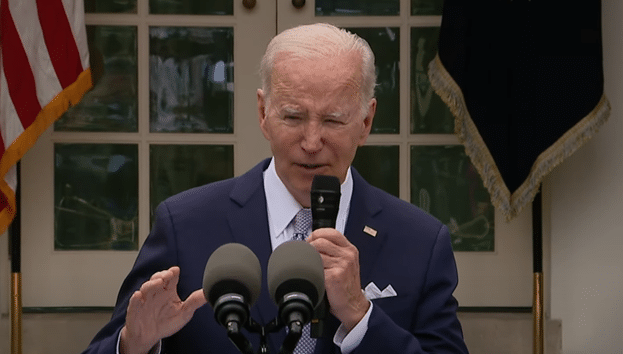
President Joe Biden is set to meet with House Speaker Kevin McCarthy (R-Calif.) and other Congressional leaders on May 9 to discuss the looming the $31.4 trillion debt ceiling. It’s about time.
So far, Biden’s only plan has been for Congress to simply increase it into perpetuity or else threaten to default, never bothering to address the dismal fiscal outlook facing the nation, even as regional banks continue to fail because of the unsustainable burden caused by taking on U.S. treasuries — a problem that will only grow as the White House Office of Management and Budget (OMB) projects the national debt will rise to $50.7 trillion by 2033.
In truth it could be much larger than that, since the debt has been growing at more than 8 percent a year on average since 1980. In fact, if it continues at its current clip, it will rise to more than $100 trillion by 2037.
Either way, $50 trillion or $100 trillion, or most likely somewhere in between, who is going to buy all of those treasuries?
Why, U.S. banks will, naturally, as foreign governments continue to reduce their overall share of U.S. treasuries. In the Dec. 2008, foreign central banks and financial institutions owned $3 trillion out of the $9.9 trillion national debt, or 30.8 percent. In Jan. 2023, they owned $7.4 trillion out of the $31.4 trillion debt, or 23.5 percent.
U.S. financial institutions, retirement funds, hedge funds, mutual funds and so forth have already increased their share of treasuries, rising from about 17 percent in 2008, or $1.7 trillion, to a massive $11.9 trillion, or 38 percent today — the largest single holder of the debt.
We won’t get it from Social Security and Medicare. The surpluses are gone as the current $6.7 trillion of debt held by the Social Security, Medicare and other trust funds is also a dwindling share of the debt, from $4.3 trillion out of $9.9 trillion in Dec. 2008, or 43 percent, to $6.8 trillion out of $31.4 trillion, down to 21.6 percent. The trust funds are set to be exhausted over the next decade, so grandma and grandpa won’t be there to bail us out anymore.
And as we learned with the massive expansion of M2 by more than $6 trillion due to Covid, in which the Federal Reserve expanded its own U.S treasuries holdings by $2.9 trillion to the current $5.2 trillion, when the Fed prints money for the debt for helicopter money — universal income, anyone? — it’s highly inflationary.
In fact, the central bank increased its share of the debt from $790 billion in Aug. 2007 when the global financial crisis began, or 8.8 percent of the then $8.9 trillion national debt, to $5.28 trillion out of the $31.4 trillion debt as of April 2023, or 16.8 percent.
Thanks to the Covid spending splurge, combined with economic lockdowns and production halts, it was literally too much money chasing too few goods as inflation peaked at 9.1 percent in June 2022. As a result, interest rates rose, as they must when spending gets out of control, with 30-year mortgage rates peaking at 7.1 percent in Oct. and Nov. 2022.
So, what does everyone think will happen when we follow the baseline spending plan under current law that takes annual outlays from $6.3 trillion in 2023 to $9.9 trillion by 2033? Any wars or recessions between now and then, and it could be a lot more than that. And whatever shortfall there is in financing from foreign and U.S. banks, the Fed has already demonstrated they will intervene, but they can’t do it all, and so U.S. financial institutions will continue to bear an increasing debt burden.
If inflation jumps again, so will interest rates, and U.S. banks that we all depend on will feel the pain, having already claimed First Republic Bank, Silicon Valley Bank and Signature Bank. All told, banks are said to be sitting on some $600 billion of unrealized losses, simply because as interest rates rose, again, as they must to combat inflation, the value of government bonds decreased.
This is an unsustainable system, and ultimately, it will lead to a digital currency as banks demand protection from bank runs when they come under stress, lead to more bank failures and further consolidation into fewer larger institutions, and taking ever more liberty from the American people who are hostages to the game of chicken we are playing with the debt.
In contrast, House Speaker Kevin McCarthy (R-Calif.) and House Republicans have passed a plan, the Limit, Save, Grow Act, that increases the debt ceiling, yes, but in exchange for real spending cuts from the currently spiraling baseline spending. The Congressional Budget Office has released its estimate of the plan, H.R. 2811, that will reduce budget deficits by a whopping $4.8 trillion through 2033, all without touching Social Security and Medicare.
And believe it or not, that’s just the start of what we must do to begin to get our fiscal house in order. Slowing down spending will help the economy to catch up to our debt burden, reduce inflation and put less stress on U.S. financial institutions to shoulder the massive debt burden going forward. In the meantime, President Biden is playing chicken with default, refusing to consider even these modest cuts as financing for the Treasury could begin to run out in just a few weeks.
The truth is, no bill raising revenue can become law without first originating in the U.S. House of Representatives under Article I, Section 7 of the Constitution, making Limit, Save, Grow the only game in town. Biden is going to have to sit down with McCarthy sooner or later and start this very important conversation — before it is too late.
Robert Romano is the Vice President of Public Policy at Americans for Limited Government.





